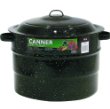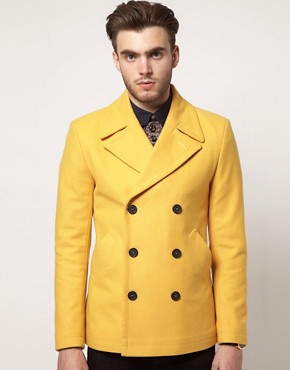How can I dye a washable bright yellow lined wool peacoat?
How can I dye a washable bright yellow lined wool peacoat?
Name: Maiko
—ADVERTISEMENTS—
Enameled canning pots make good dyeing kettles

Granite Ware 21-1/2-Quart Steel/Porcelain Canner
Country or region: United States
Message: Hi, I would like to know how I can dye a coat like the one I linked below. The description says it is wool blend. I don't know if it matters, but here are more details on the coat:
 Fabric: 70% Wool, 30% Polyamide
Fabric: 70% Wool, 30% PolyamideLining: 80% Polyester, 20% Cotton
Sleeve Lining: 100% Polyester
I would really appreciate your help.
Don't buy this coat in order to dye it, unless you see it being sold for something like $10. If you own it already, don't dye it unless you are prepared to risk destroying the coat in the process. Clothing like this is unpredictable; it may or may not be dyeable, so it is not worth paying even sale prices for it, in order to dye it. A big problem is that even dyeable fibers are often coated with treatments that prevent dye from reaching the fiber evenly. There may be blotches of fabric-finish chemicals that are invisible now, but which will become sadly visible upon dyeing. Different sections of the garment may have been cut from different bolts of fabric, so that although they match in color now, they will come out obviously different after dyeing.
Dyeing a lined garment is particularly problematic. Chances are that either the inner or the outer layer will shrink more than the other layer. When this happens, the shape of the garment is permanently ruined; it never lays right again. Your coat is labeled as being washable, which is encouraging; however, both the wool and the nylon ('polyamide') in the outer layer require heat in order to fix the dye that must be used on them. Wool and nylon are dyed with a type of dye called acid dye. I am sure that the washing instructions for that coat call for cold water, which will not work for dyeing it. Hot water is likely to cause at least a little shrinkage in one of the layers. You can't be at all sure that the coat will look right after dyeing.
If you do decide to go ahead and dye this coat, you must first acquire a very large non-reactive cooking pot for dyeing. The pot must be large enough for the coat to move in freely, in the dye water, as you stir it. You can't use an aluminum pot, although those are the cheapest sort, because aluminum will react with the acid (usually vinegar) that must be used along with the acid dye. This means that you must find either an enamel pot or a stainless steel pot; the size should be at least five gallons, I think, depending on the size of the coat. If the fabric fits too tightly in the dyeing pot, then the dye will take unevenly, lighter in some areas and darker in others. A five-gallon enamelware pot will cost you at least $40 or $50. On the other hand, if your goal is to obtain a multi-colored result, whether tie-dyed or not, you can do it with a somewhat smaller pot; I will give you more information about that if you wish. In my opinion, this project might be worth the risk if you want a multi-colored effect, but not if you are trying to produce an ordinary dark solid-colored version of the coat shown in the picture.
You will not be able to dye the polyester lining of the coat, so its current color is the one you will have to live with, if you dye the coat. The same is true of the polyester stitching which was used to sew the jacket together. Yellow stitches might look odd on a darker-colored coat. Polyester cannot be dyed except by extensive boiling with a special polyester dye; the amount of boiling required is sure to shrink the coat. Wool and nylon are much easier to dye than polyester is. I would recommend that you dye wool and nylon at a temperature around 185°F.
The two best approaches to garment dyeing are to purchase clothing labeled PFD (for "Prepared To Dye") or RTD (for "Ready To Dye"), or, if you can't find a suitable garment, to dye yardage and hire a tailor or seamstress to sew it together for you. Dyeing other clothing, whether used or new, is always a gamble; it's a fun gamble and often works, but certainly not always. You must be prepared for a real rate of failure. PFD clothing is much more reliable, but unfortunately I haven't seen any PFD coats for sale anywhere. I have seen a pattern for a similar coat for sale on Etsy, which you might be able to get someone to sew for you.
(Please help support this web site. Thank you.) .
(Please help support this web site. Thank you.) .
Posted: Monday - December 17, 2012 at 03:39 PM
Follow this blog on twitter here.
Quick Links
- All About Dyes & Dyeing Top -
- Top of this blog -
- FAQ -
- The Dye Forum -
- How to Tie Dye - How to Batik -
- Books - Toys - Plants -
- Top of this blog -
- FAQ -
- The Dye Forum -
- How to Tie Dye - How to Batik -
- Books - Toys - Plants -
More in this category:
- -
Statistics
Total entries in this blog:
Total entries in this category:
Published On: Dec 17, 2012 04:39 PM
Total entries in this category:
Published On: Dec 17, 2012 04:39 PM